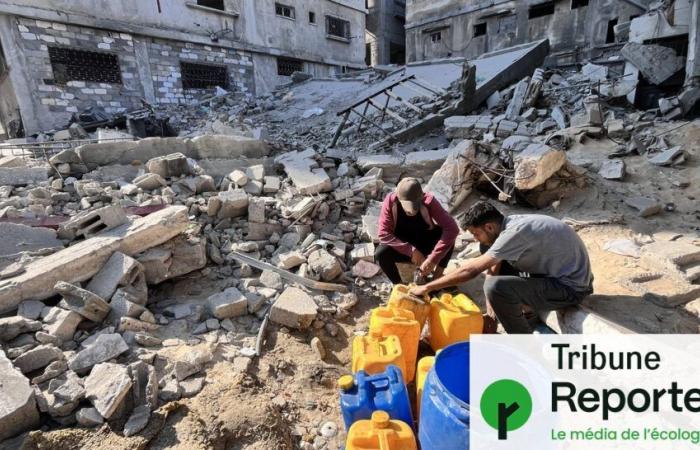William Mina works as a mediator and group facilitator with actors in the social and solidarity economy. He is also involved in political ecology and solidarity movements with Palestine and Lebanon.
Israel today uses the thirst of the Gazan population and the pollution of water as weapons of war. In July 2024, Oxfam estimated the average amount of water accessible in Gaza at just under 5 liters per day per person, while 15 liters daily is considered necessary for survival in an emergency situation, according to the United Nations. .
Destructive of populations and marine ecosystems, this war violates one of the fundamental human rights highlighted by the declaration of July 28, 2010 by the United Nations General Assembly, the right to water.
Gazans today use untreated wastewater for washing and washing their clothes. And while some are making makeshift desalination systems from pebbles, sand, coal and cotton, more and more children are quenching their thirst in puddles of water contaminated by waste.
Intentional destruction
This exploitation of water by Israel is not visible at first glance in the cataclysmic images that reach us from local news sources. An entire system emerges from the repetition of actions denounced by the United Nations (HIM) and several ONG :
- the destruction or damage of more than two thirds of wells and water reservoirs, as well as desalination units ;
- the inability to produce pumps and desalination units that are still functional, through the obstruction of fuel delivery, as currently in northern Gaza ;
- disabling all wastewater treatment units ;
- the total or partial interruption of water delivery by the Israeli national company Mekorot, whose three lines have only supplied, since October 7, 2023, 22 % of quantities previously transported ;
- the destruction of the only two water quality testing laboratories ;
- contamination of water sources and the Mediterranean shore by wastewater and by heavy and toxic metals (white phosphorus, asbestos, etc.) from weapons and debris ;
- blocking of equipment needed to repair destroyed water infrastructure ;
- forced displacement making certain still functional facilities inaccessible ;
- the assassinations of professionals during interventions on infrastructures ;
- the assassinations of civilians refilling with water…
The methodical subjection of the population of Gaza to thirst and pollution is one of the acts of the ongoing genocide. Its intentional nature has been explicitly exposed in the statements of several Israeli politicians, such as Giora Eiland, advisor to the Minister of Defense, who declared on October 10, 2023 on the station GLZIsraeli Army Radio: « If Gaza's energy shortages made it impossible to pump water, that would be a good thing. Otherwise, we will have to attack the water treatment infrastructure to cause thirst and hunger in Gaza and, I would argue, portend an unprecedented economic and humanitarian crisis. » [1]
There is no shortage of evidence for the application of these statements. Thus, on July 26, 2024, an Israeli soldier from 601e Engineer Combat Battalion posted a video on Instagram showing the premeditated destruction of a major Rafah facility capable of supplying half the city's population with clean water.
Hepatitis A, polio, cholera…
The situation is such that water-borne diseases (hepatitis A, polio, cholera, dysentery, acute diarrhea, typhoid) and dehydration are proliferating. 669,000 cases of diarrhea, one of the leading causes of infant mortality, have been counted since October 7, 2023 by the Office for the Coordination of Humanitarian Affairs of theHIM (Ocha), who also estimated at the end of September that 76 % of partially functioning hospitals were not adequately supplied with water.
Added to those caused by the destruction of food, housing and health conditions, these diseases could have already led to consequences just as deadly as the bombings themselves. According to estimates from a group of American health professionals who have volunteered in Gaza since October 7, 118,000 people may have already died due to the conflict, out of a population of approximately 2,160,000 people. 2,300 deaths each month could be attributed to infectious diseases, according to the London School of Hygiene and Tropical Medicine.
« 2,300 deaths each month could be attributed to infectious diseases »
Even if the war ended tomorrow, Gaza would remain uninhabitable for a long time. Hundreds of thousands of m3 of wastewater will continue, for several years after the bombing ceases, to flow into the sea, condemning marine fauna and fishing activity. To the destruction of water infrastructure, it will be necessary to add the pollution which will result from all the other destruction of buildings, the tens of millions of debris (including 800,000 tonnes potentially containing asbestos) which, in addition to promoting air from respiratory diseases and cancers will contaminate the aquifer already polluted by runoff.
The time and scale of the efforts required to rebuild the infrastructure will far exceed what Gaza has experienced after each of the past wars, and it is reasonable to believe that the Israeli authorities, in accordance with their usual strategy of obstruction, will not do so. will not facilitate.
Despite the arrest warrants issued very recently by the International Criminal Court against the Israeli Prime Minister, Benjamin Netanyahu, and his former Defense Minister, Yoav Gallant, for war crimes and crimes against humanity in the Gaza Strip , there is nothing to suggest that sanctions capable of interrupting Israel's campaign of extermination will be put in place any time soon. What would also be revealed in this case is that the current international order is not capable of ensuring the most basic fundamental rights such as the right to water.
legend






